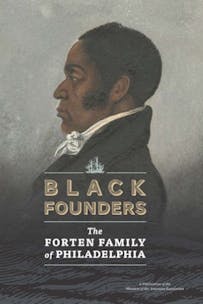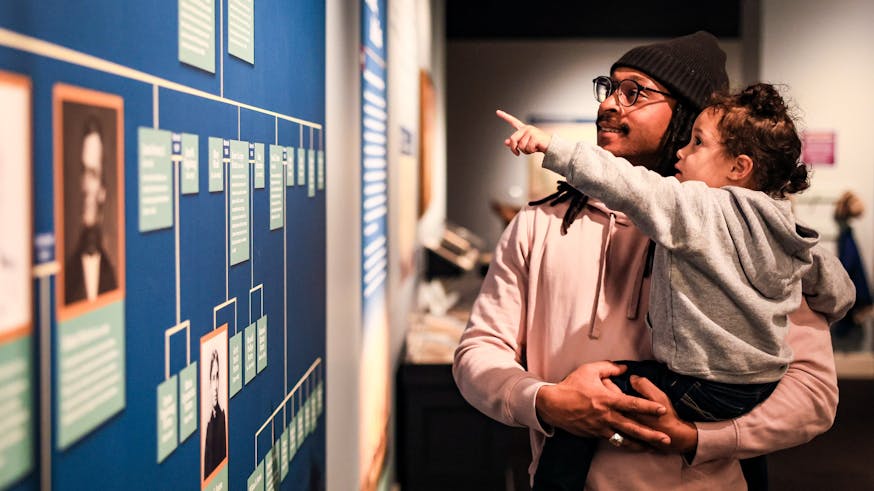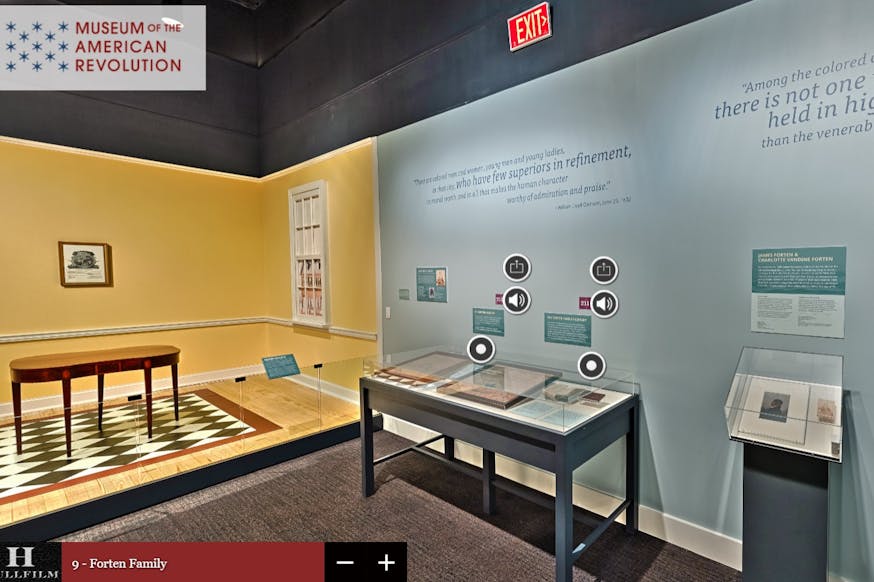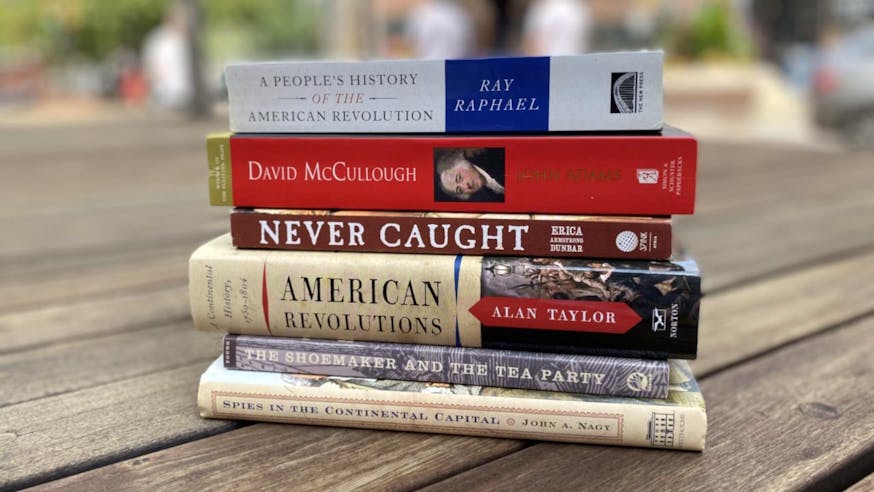Read the Revolution
Black Founders
August 23, 2023
Purchase the book from the Museum Shop.
The Museum’s exhibition catalog, Black Founders: The Forten Family of Philadelphia, guides readers through the groundbreaking special exhibition on view through Nov. 26, 2023, and available online anytime as a virtual tour. The book takes readers through James Forten’s time as a young boy living in Philadelphia, his service aboard a privateer ship, his successful sail-making business, and his tireless fight to abolish slavery in the newly formed United States.
Forten’s children and grandchildren continued the fight for equal rights and ending slavery after he died on March 4, 1842. As the Civil War broke out on April 12, 1861, two of Forten’s sons aided the cause against the Confederacy, as William Deas Forten joined the efforts to recruit people for the protection of Philadelphia and Robert Bridges Forten recruited for the newly formed United States Colored Troops (USCT). One of Forten’s grandchildren, Charlotte L. Forten, traveled to South Carolina to educate previously enslaved people, while another, Charles Burleigh Purvis, became a nurse in Washington, D.C., during the war. The catalog provides images of objects on display in the exhibition, some of which had never been publicly on view before Black Founders opened. It also introduces readers to other important people in James Forten’s life who inspired him and helped fight for the abolition of slavery.
Read an excerpt about the Civil War and learn about Forten’s descendants who made it a priority to fight against the Confederacy and help previously enslaved people begin a new life.
Excerpt
The outbreak of the American Civil War in 1861 tore the nation apart.
The Forten family stood firm in their beliefs and hoped that the war would be the final chapter of American slavery. Putting their full might behind the Union cause, they hoped that the United States would revive its commitment to equality. The Fortens celebrated the Emancipation Proclamation in 1863, but they knew more work was needed to destroy slavery and support freed African Americans.
Charlotte L. Forten, daughter of Robert Bridges Forten and Mary Virginia Wood Forten, traveled to South Carolina during the war to teach and support formerly enslaved African Americans. James Forten’s son, William Deas Forten, worked to recruit Black Philadelphians for newly raised regiments of United States Colored Troops (USCT). Robert Bridges Forten and his nephew, Joseph Purvis, signed up to fight, joining the 43rd Regiment of USCT. Charles Burleigh Purvis, son of Harriet Davy Forten and Robert Purvis, nursed recently freed people back to health in a hospital in Washington, DC.
With the Union victory in 1864, the Forten family became active leaders in the Reconstruction era. Civil rights cause—especially citizenship and voting—for African Americans and women became their primary focus.
Sign Up
Get biweekly Read the Revolution featured excerpt right to your inbox.
Charlotte L. Forten: Educating Freed People
Charlotte L. Forten represented a rising third generation of the Forten family that was ready and willing to help end slavery. When Union forces seized coastal islands south of Charleston, South Carolina, in 1861, they captured thousands of enslaved people owned by southerners. This group of African Americans occupied a middle ground between slavery and freedom: they came under control of the occupying Union Army and were labeled as “contraband.” Northern abolitionists, including Robert Purvis and William Deas Forten, supported a plan to privately fund teachers and ministers to provide care and educational opportunities to the formerly enslaved people.
Charlotte L. Forten, at the age of 25, was the only Black person hired as part of this plan. Forten and her white abolitionist colleagues provided schooling and moral education to the men and women as they transitioned from slavery to freedom. One relief worker wrote that Forten “would not desert herself from the fortunes of her people, and now, not with a superficial sentiment, but a profound purpose, she devotes herself to their elevation.” Foren spent two years on the islands helping those in need and recorded her experiences in a journal.
William Deas Forten: Recruiting Black Soldiers
The Emancipation Proclamation, which took effect on January 1, 1863, declared free all enslaved people in the Confederacy and opened the door for Black men to join the armed forces of the United States. The War Department authorized recruitment of African American men to form regiments of United States Colored Troops (USCT) led by white officers. Over the next two years, more than 180,000 men enlisted in over 160 regiments of USCT. Over 8,000 of those men came from Pennsylvania, the most from any northern state.
William Deas Forten, the youngest child of James Forten and Charlotte Vandine Forten, helped lead the recruitment charge in Philadelphia, which had a Black population of over 22,000 in 1860. Forten, along with Frederick Douglass, Octavius V. Catto, and Anna E. Dickinson, organized rallies, published recruitment broadsides, and sponsored lectures. One recruitment statement signed by William Deas Forten called on Black men to “strike now, and you are henceforth and forever Freemen!”
Robert Bridges Forten: Marching for Freedom
Robert Bridges Forten, at the age of 51, enlisted in the 43rd Regiment of United States Colored Troops, which was primarily raised in the Philadelphia area. His nephew Joseph B. Purvis, the son of his sister Sarah, and her husband Joseph Purvis, enlisted too. They trained for combat at Camp William Penn, north of the city, and prepared to march south into Virginia.
Because of his education, his age, and his speaking skills, Forten was appointed the sergeant major of the 43rd Regiment. The sergeant major was the heart of the regiment, being the senior-most enlisted man who served as a model for his fellow soldiers. While recruiting more soldiers in Maryland and training others, Forten fell ill and took leave from the army. He died in his family’s home on Lombard Street on April 25, 1864, after suffering from typhoid fever. His funeral was the first ever military funeral for a Black man in the city. Joseph B. Purvis also fell ill but survived the war.
The 43rd Regiment went on to serve with distinction in and around Richmond, Virginia.
Charles Burleigh Purvis: Nursing the Sick
Born one month after his grandfather James Forten’s death in 1842, Charles Burleigh Purvis (son of Robert Purvis and Harriet Davy Forten Purvis) rose to become a prominent physician.
His medial skills were forged during the Civil War. In 1864, Purvis started working as a nurse in the Union Army and was stationed at Camp Barker in Washington, DC. Camp Barker served as a centralized place for formerly enslaved people from the South who had fled to the Union Army with the hope of freedom. The army called these people “contraband,” or property taken from the Confederates that now belonged to the Union and considered them free. After the Emancipation Proclamation of 1863, about 10,000 new Black refugees came from Union-occupied areas in the South to Washington to restart their lives as free people.
Museum of the American Revolution, Black Founders: The Forten Family of Philadelphia (Northern Liberties Press, 2023), 51-56
Tags
Learn More

Black Founders: The Forten Family of Philadelphia
February 11 - November 26, 2023
Black Founders Virtual Tour

